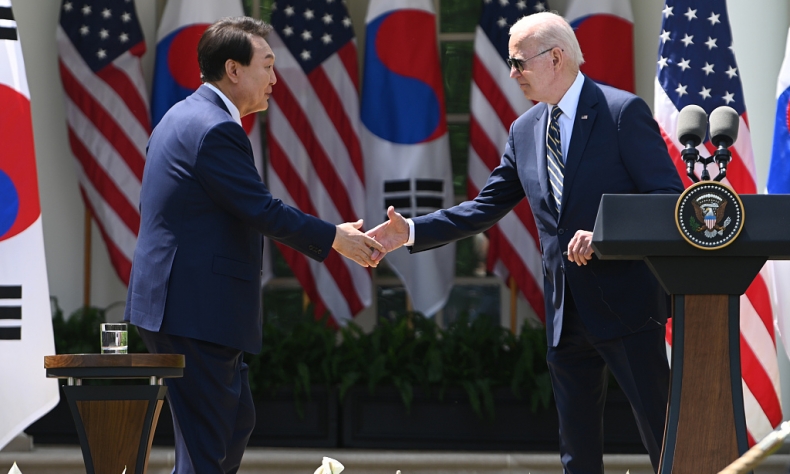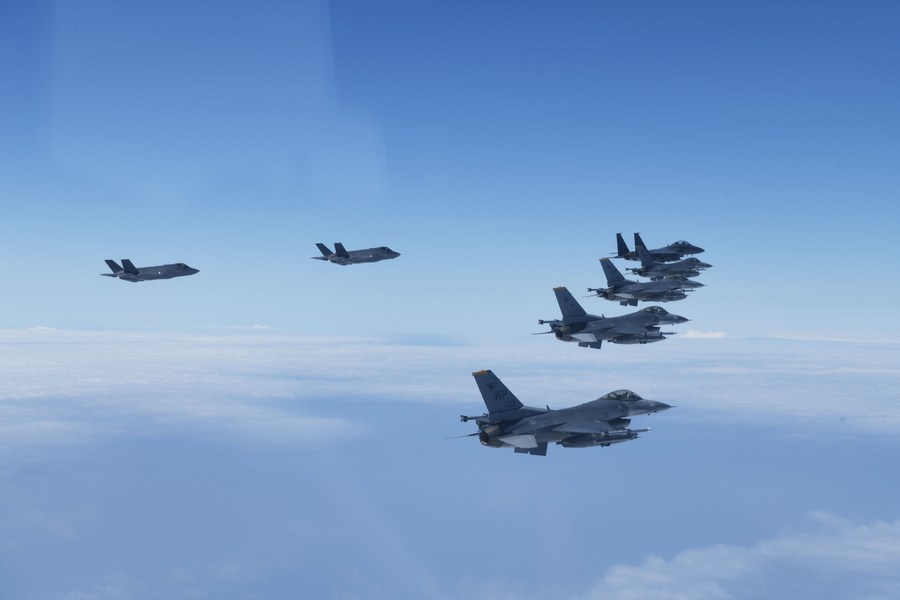The Danger Game

If the U.S. insists on building a miniature NATO model in the region, the shadow of the Cold War will eventually return to the Korean Peninsula.
On the occasion of the 70th anniversary of the signing of the Mutual Defense Treaty between the U.S. and the Republic of Korea (ROK), President Yoon Suk-yeol paid a state visit to the U.S. from April 24 to 30. As a landmark event in the further strengthening of the U.S.-ROK alliance, the two sides announced the Washington Declaration, in which the U.S. promised to provide the ROK with a more solid “nuclear umbrella
,” including the establishment of a new nuclear consultation working group by the two sides and the dispatch of U.S. ballistic missile nuclear submarines to ROK waters.
Securing the nuclear protection commitment of the U.S. is considered the biggest “achievement” of Yoon’s visit. Since coming to power in May 2022, the Yoon administration has actively sought to play a more important role in Uncle Sam’s global strategic layout and improve relations with Japan to a certain extent, but has raised concerns among neighboring countries, especially the Democratic People’s Republic of Korea (DPRK) in the north.
It is worth noting that the real root of the peninsula’s division does not lie in the historical Korea. After Korea was liberated from Japan’s 35-year colonial rule at the end of World War II, the U.S. and the Soviet Union agreed to temporarily divide Korea at the 38th parallel of latitude north of the equator and established completely different social systems on the north and south sides. Two countries of one ethnic group were basically forced to be hostile to one another. In the following decades, the Korean Peninsula became one of the most forward positions of the Cold War, and small-scale conflicts have occurred almost uninterrupted.
After the collapse of the Soviet Union, the DPRK has paid the huge price of being severely sanctioned by the international community in order to develop nuclear weapons and its deep-seated motives for this choice have been ignored. In addition to the need to maintain its own regime, the hope of having the power to decide its own destiny has always been the goal pursued by the country.

Although there is a big gap with the ROK in terms of conventional military power and economic strength, the nuclear weapons possessed by the north still place the ROK under tremendous security pressure. There has been no lack of domestic voices calling for the ROK to independently develop a nuclear weapons program, and these voices have only grown stronger in recent years. The ROK has been hoping to completely change the balance of power between the two sides through its own sustained development, so as to achieve the goal of peaceful reunification. But now the ROK is, in fact, deviating from the basic position of “engagement and dialogue” that it has pursued for many years and the delicate balance on the peninsula is going to be broken.
In the context of the increasingly tense situation on the Korean Peninsula, the nuclear protection provided by the U.S. at this time is undoubtedly a guarantee of confidence for Seoul to continue its diplomatic strategy. On a positive note, the ROK will maintain its nuclear-free status under the Washington Declaration and will continue to comply with all the conditions of the non-proliferation treaty, to which it is a signatory. However, the redeployment of the American nuclear forces on the peninsula does not seem to be as simple as responding to the DPRK’s nuclear deterrence, and increasing its strategic leverage against China and Russia may be the real purpose. The Washington Declaration has clearly surpassed the bilateral agreement and will have a profound impact on the security situation in the entire Northeast Asia region.
If the U.S. nuclear presence on the peninsula leads to an escalation of tensions or even a nuclear stalemate, the situation will be far more complicated than the 1963 Cuban Missile Crisis: There will be six de facto nuclear-armed countries around a peninsula of 221,000 square km—the U.S., Russia, China, Japan, the ROK and the DPRK—so any security issue in the region is extremely sensitive.
Even if each side maintains maximum restraint to avoid the outbreak of warfare, it seems impossible to avoid the escalation of military tension and confrontational atmosphere in the Far East. If the U.S. insists on building a miniature NATO model in the region, the shadow of the Cold War will eventually return to the Korean Peninsula.
This is a game of danger and the most frightening thing is that the participants underestimate its risks.
 Facebook
Facebook
 Twitter
Twitter
 Linkedin
Linkedin
 Google +
Google +










